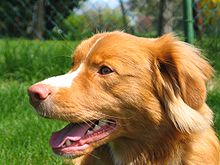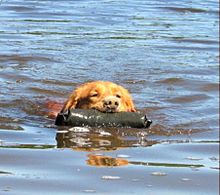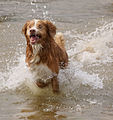- Nova Scotia Duck Tolling Retriever
-
Nova Scotia Duck-Tolling Retriever 
Tolling Retriever Other names Yarmouth Toller
Tolling Retriever
Little Red Duck Dog
Little River Duck DogNicknames Toller, Scotty, Novie Country of origin Canada (Nova Scotia) Traits Weight Male 20–23 kg (44–51 lb) Female 17–20 kg (37–44 lb) Height Male 48–51 cm (19–20 in) Female 45–48 cm (18–19 in) Coat Medium-length coat with a softer, dense undercoat Litter size 6–10 pups Life span 12–14 years Classification and standards FCI Group 8 Section 1 #312 standard AKC Sporting standard ANKC Group 3 (Gundogs) standard CKC Group 1 - Sporting Dogs standard KC (UK) Gundog standard NZKC Gundog standard UKC Gun Dogs standard Dog (Canis lupus familiaris) The Nova Scotia Duck-Tolling Retriever, or Toller for short, is a medium sized breed of gundog bred primarily for hunting. The dog originated in southwestern Nova Scotia, Canada. It is the smallest of the retrievers.[1][2]
Contents
Use in hunting
Tollers are named for their ability to entice or lure waterfowl within gunshot range, called "tolling". The hunter stays hidden in a blind and sends the dog out to romp and play near the water, usually by tossing a ball or stick to be retrieved. Appearing similar to a fox, the dog's unusual activity and white markings pique the curiosity of ducks and geese, who swim over to investigate.[2]
When the birds are close, the hunter calls the dog back to the blind, then rises, putting the birds to flight, allowing him a shot. The Toller then retrieves any downed birds. They are particularly suited for retrieving in cold water climates because of their water-repellent double coat.[2]
History
The breed was developed in the community of Little River Harbour in Yarmouth County, Nova Scotia, around the beginning of the 19th century to toll waterfowl.[1] Its exact origins are not known but it appears that some Cocker Spaniel, Golden Retriever, or Irish Setter may have gone into the mix.[2] It may share origins with the smaller Kooikerhondje, which has a similar method of work.[citation needed]
The Toller was officially admitted to the Canadian Kennel Club in 1945.[3] Some consider that the breed came of age in 1980, when two Nova Scotia Duck-Tolling Retrievers were awarded Best in Show at championship events that included many breeds.[4] On June 11, 2001, it was approved for admission into the Miscellaneous Class of the American Kennel Club and was granted full recognition into the Sporting Group on July 1, 2003.[5]
The Toller was made the provincial dog of Nova Scotia in 1995.[3]
Description
Appearance
The breed is often mistaken for small Golden Retrievers, but the Toller is more active, both physically and mentally.[6] According to the breed standards, the Toller should be athletic, well-muscled, compact, medium boned, balanced and powerful. The chest is deep. Conformation judges require Tollers to be capable of tolling, and physical faults that inhibit working ability are heavily penalized. They should be of moderate build—a lack of substance or a heavy build are penalized by judges, as both detract from the type and athleticism. The legs are sturdy and solid. Tollers have webbed feet.[1][2]
Those who breed Tollers for conformation shows consider the head (clean cut, slightly wedge-shaped) to be an important feature, and believe it should resemble that of a fox and must never be blocky like that of a Golden Retriever. The ears are triangular and set high and well back from the skull.[1][2] The tail is well feathered and held jauntily when the dog is excited or moving.[1][2]
Color is any shade of red, ranging from a golden red through dark coppery red, with lighter featherings on the underside of the tail, pantaloons, and body. Even the lighter shades of golden red are deeply pigmented and rich in color. The Toller should not be buff or brown.[1][2] Although very rare, there are chocolate/liver brown Duck Tollers.
The Toller has usually at least one of the following white markings: tip of tail, feet (not extending above the pasterns), chest, and blaze. Lack of white is not a fault. Dogs with white on the shoulders, around ears, back of neck, or across back or flanks, or with silvery, grey or black areas in coat are disqualified from conformation shows.[1][2]
The Toller was bred to retrieve from icy waters and must have a water-repellent double coat of medium length and softness, and a soft dense undercoat. The coat may have a slight wave on the back, but is otherwise straight. Some winter coats may form a long loose curl at the throat. Featherings are soft and moderate in length. The hair on the muzzle is short and fine. Seasonal shedding is to be expected.[1][2]
Size and proportions
Tollers are the smallest of all the retriever breeds.[1][2][3] They range in height from 17–21 inches (43–53 cm) at the withers, and weigh 40–55 pounds (18–25 kg), with females being slightly shorter and lighter.[6] Tollers are always a medium-sized breed, never large; however, there has been a trend towards larger dogs in recent years.[1][2]
Tollers should be slightly longer than tall (a ratio of approximately 10 to 9). However, they should not appear long-backed.
Temperament
Nova Scotia Duck-Tolling Retrievers are known to be very intelligent, alert, high-energy dogs. [7] They tend to be very affectionate and outgoing animals with family members and are known for being very patient with children. Some dogs may be reserved in new situations but they are not shy.[citation needed] They excel at many types of competitions, such as agility and obedience.
Duck Tollers are working animals and are happiest when they have a job to do. Physical stimulation should be provided for these dogs each day, as they may become destructive when they are not exercised enough or left alone for too long. [8] They have a strong retrieving drive, intense birdiness, endurance and a love for water. {Citation needed|date=August 2011}}
Health
Tollers are generally hearty. However, like almost all dog breeds, certain genetic disorders are known to occur in the breed. This is sometimes blamed on a relatively small gene pool. The Toller's hereditary diseases include Addison's disease, progressive retinal atrophy, and hip dysplasia.
The average life span is about 12–14 years.
Gallery
References
- ^ a b c d e f g h i j Canadian Kennel Club. "CKC Breeding Standards: Nova Scotia Duck-Tolling Retriever". http://www.ckc.ca/en/Default.aspx?tabid=99&BreedCode=RNS. Retrieved September 7, 2010.
- ^ a b c d e f g h i j k l American Kennel Club. "Nova Scotia Duck-Tolling Retriever". http://www.akc.org/breeds/nova_scotia_duck_tolling_retriever/index.cfm. Retrieved September 7, 2010.
- ^ a b c Government of Nova Scotia. "Symbols: Nova Scotia Duck-Tolling Retriever". http://www.gov.ns.ca/legislature/HOUSE_OF_ASSEMBLY/Symbols/dog.htm. Retrieved September 7, 2010.
- ^ Nova Scotia Legislature: Duck Toller
- ^ The Nova Scotia Duck-Tolling Retriever: A true Canadian canine (eh?)
- ^ a b Palika, Liz (2007). The Howell Book of Dogs. John Wiley & Sons. p. 307. ISBN 978-0470009215. http://books.google.co.uk/books?id=9z_n9mDY2tcC&pg=PA307&dq=nova+scotia+duck+tolling+retriever#v=onepage&q=nova%20scotia%20duck%20tolling%20retriever&f=false.
- ^ "Nova Scotia Duck Tolling Retriever : Dog Breed Selector: Animal Planet". Animal Planet. http://animal.discovery.com/breed-selector/dog-breeds/sporting/nova-scotia-duck-tolling-retriever.html. Retrieved 3 November 2011.
- ^ "Nova Scotia Duck Tolling Retriever Temperament: What's Good About'Em, What's Bad About'Em". yourpurebredpuppy.com. http://http://www.yourpurebredpuppy.com/reviews/novascotiaducktollingretrievers.html. Retrieved 3 November 2011.
Dogs originating in Canada Extant Canadian Eskimo Dog · Ganaraska · Labrador Retriever · Landseer · Newfoundland · Nova Scotia Duck Tolling Retriever · Seppala Siberian Sleddog · Valley Bulldog
Extinct Breeds of gundog Pointers English Setter · Gordon Setter · Irish Red and White Setter · Irish Setter · Llewellin Setter · PointerVersatile gundogs Ariege Pointer · Blue Picardy Spaniel · Bracco Italiano · Braque du Bourbonnais · Braque d'Auvergne · Braque Français · Braque Saint-Germain · Brittany · Burgos Pointer · Cesky Fousek · Drentsche Patrijshond · German Longhaired Pointer · German Shorthaired Pointer · German Wirehaired Pointer · Münsterländer (Large) · Münsterländer (Small) · Old Danish Pointer · Pachón Navarro · Picardy Spaniel · Portuguese Pointer · Pudelpointer · Slovakian Rough Haired Pointer · Spinone Italiano · Vizsla · Weimaraner · Wirehaired Pointing GriffonRetrievers Spaniels Water dogs American Water Spaniel · Barbet · Cantabrian Water Dog · Irish Water Spaniel · Lagotto Romagnolo · Poodle · Portuguese Water Dog · Spanish Water Dog · WetterhounCategories:- Dog breeds
- Sporting dogs
- Provincial symbols of Nova Scotia
- Dog breeds originating in Canada
Wikimedia Foundation. 2010.










